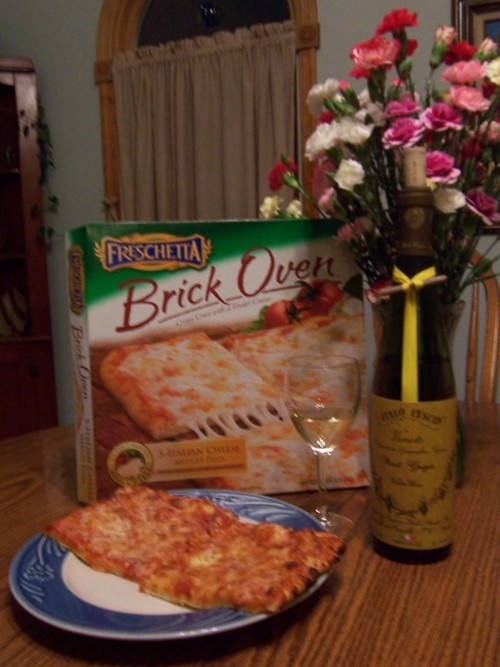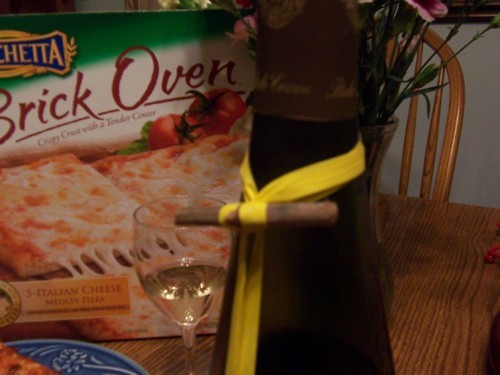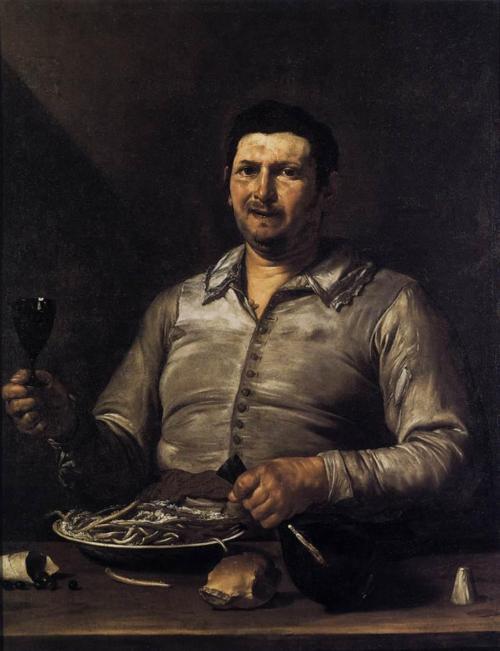The site of last week’s reunion offered “a little taste of Tuscany in Horsham.” Unfortunately, I cannot say whether that claim is true, for a couple of reasons: One, I’ve never been to Tuscany; and two, I did not partake in the food. In any event, one authentically Italian aspect of the restaurant that I did experience was the exceedingly rude wait staff. However, their heavily accented, garlic-scented surliness gave me a hankering for an authentic Italian pizza. So, enjoy selections from Sun Araw's Ancient Romans as this week’s pairing is unveiled:

What rustic authenticity! A Freschetta Brick Oven Pizza, of the 5-Italian Cheese Medley variety, and Italo Cescon Pinot Grigio ($10.99, from Veneto, Italy). First, the pizza: It is square; a legendary shape for which the brick ovens of Italy are famous, or so Freschetta and its owners, the Minnesota-based Schwan Food Company, tell us. And, since it’s square, it will undoubtedly taste as if it’s been baked slowly in a wood-fired brick oven, rather than in the modern, gas-powered, stainless steel monstrosity that heats my meals so soullessly.
Next, the wine: Tied to the bottle is an actual twig from the vines that yielded this authentically rustic vintage!

The label includes an explanation that merits quoting in full:
The idea of the "tralcetto" was born on a winter’s day of rest and meditation for the men working in the vineyard. While collecting the vines that had been pruned, grandmother Anna saved a small piece of vine and placed it in her apron pocket. When she returned home, she was assisted by her son Italo, who was a wine grower, to tie the piece of vine (tralcetto) with a string at the neck of a wine bottle. Doing this symbolized that the wine had been grown from that vine, and that it had been produced through the hard work of grandmother Anna’s hands. From that moment on, in 1957, the story of the “tralcetto” began and still identifies today Italo Cescon’s classic production of genuineness, representing the wine and the simple way to preserve it.
A thousand thanks to grandmother Anna and her son (who is named Italo, no less!) for providing irrefutable proof of the genuineness, the rusticity, and the authenticity of this wine! So immersed am I in the aura of the Italian countryside that, as I sit down to my autentica festa italiana, I fully expect to look up and see this rustic fellow, who may or may not be Italo, in the adjacent seat.

(Jusepe de Ribera, The Sense of Taste, c. 1614-1616; oil on canvas; Hartford, CT, Wadsworth Atheneum. Is that you, Italo?)
And now, finally, to the tasting: Ugh. If this were my only experience of “authentic Italian pizza,” it would lead me to believe that the traditional ingredients included Wonderbread, ketchup, and Kraft singles. The wine’s website boasts of a “deep-yellow, straw-like color,” before proceeding, unnecessarily, to the flavor notes. I say unnecessarily because “deep-yellow” and “straw-like” suffice to describe the taste of this rancid vintage. In fact, I suspect Italo may have micturated in the casks for a laugh. Together, the flavors combine to produce the impression of what it must feel like to be a squalid child consuming a sandwich, made of the aforementioned ingredients, after relieving himself sloppily and not washing his hands. Other than the possible urine content of the wine, the only authentically Italian aspect of this pairing that I can identify is the awkwardly written, essentially nonsensical description of the tralcetto (re-read the final sentence, in particular), characteristics which suggest that it was composed by a native Italian speaker, or is perhaps the result of a Google translation.
This is sorely disappointing, as well as embarrassing. I have been suckered by slick presentation and quaint rhetoric. Sadly, I cannot recommend this pairing; unless, that is, you happen to want to pay $5 extra to have a sprig of vegetation bound to your bottle of wine.
(Published originally on November 30th, 2011.)
No comments:
Post a Comment